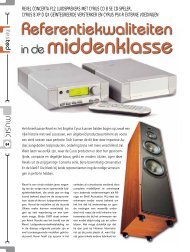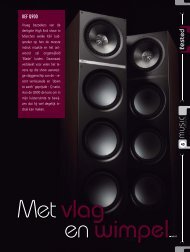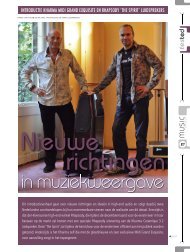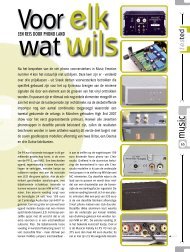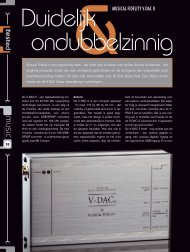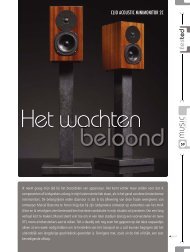The Official Magazine of ISE 2012 - Amazon S3
The Official Magazine of ISE 2012 - Amazon S3
The Official Magazine of ISE 2012 - Amazon S3
Create successful ePaper yourself
Turn your PDF publications into a flip-book with our unique Google optimized e-Paper software.
DiSCO fever<br />
returns to<br />
Amsterdam!<br />
<strong>The</strong> history <strong>of</strong> advertising is a fascinating one. As an industry,<br />
it dates back thousands <strong>of</strong> years to Egypt, Greece and Rome. It<br />
wasn’t until 1836, however, that the first paid-for advertising in<br />
newspapers appeared in France. Inevitably, the advent <strong>of</strong> radio in<br />
the 1920s quickly saw advertising assume significant commercial<br />
importance – and that carried through to television. In 1965,<br />
advertisers could reach 80% <strong>of</strong> Americans aged 18-49 by running<br />
TV commercials on only CBS, NBC and ABC. By 1994, the ‘big<br />
four’ networks – which now included Fox – reached a 52% primetime<br />
audience share. By 2004, that share was down to 31%. That<br />
decline was indicative<br />
<strong>of</strong> a change in how<br />
society worked, and how<br />
advertisers responded to<br />
those changes. <strong>The</strong> move<br />
from mass marketing<br />
to the need to address<br />
increasingly smaller<br />
groups – and eventually,<br />
individuals – had begun.<br />
It has been said that<br />
the history <strong>of</strong> digital signage began in the 1970s, with VCR/<br />
TV-based advertising in retail outlets. Realistically, however, as<br />
the industry we know today, it dates back to the late 1980s and<br />
early 1990s when the company we now know as Scala developed a<br />
system for the Commodore Amiga.<br />
Digital signage has, then, been around for a while: but, within<br />
the wider context <strong>of</strong> communicating with potential customers, it is<br />
still relatively immature. <strong>The</strong>re is still plenty to learn, and it’s that<br />
notion that sees DiSCO – the Digital Signage Conference return<br />
to <strong>ISE</strong>. A joint venture between <strong>ISE</strong>, its signage industry partner<br />
Invidis Consulting and the trade association OVAB Europe,<br />
DiSCO will, as it did in 2011, take place the day prior to <strong>ISE</strong>.<br />
“<strong>The</strong> timing is perfect,” smiles Oliver Schwede, senior analyst<br />
at Invidis Consulting. “Running the conference the day before <strong>ISE</strong><br />
starts will give attendees all the important information they need<br />
so that they can ask the right questions on the show floor. <strong>The</strong><br />
conference educates the attendees and provides direction to find<br />
the right solution within the huge amount <strong>of</strong> exhibitors. It simply<br />
makes the visit to <strong>ISE</strong> more effective.”<br />
“Digital signage and Digital out <strong>of</strong> Home are two dynamic<br />
42 Rise<br />
and rapidly evolving markets,” continues Schwede. “Despite the<br />
fact that these markets have existed since the mid-1990s, there<br />
are many unanswered questions, especially regarding sustainable<br />
business cases and effective concepts. <strong>The</strong> conference will pick up<br />
on these issues and will focus on best practice, strategic background<br />
information and market figures. <strong>The</strong> program will provide a<br />
balanced mix <strong>of</strong> these categories.”<br />
This year, the format <strong>of</strong> the DiSCO conference will be<br />
slightly different, in that it will see presentations alternating<br />
between the story as told by the user – focusing on the concept,<br />
issues and solutions –<br />
and the view <strong>of</strong> the<br />
supplier or manufacturer<br />
who will provide the<br />
perspective from ‘the<br />
other side’, looking at the<br />
technologies and products<br />
that were the platform for<br />
the solution.<br />
<strong>The</strong> gradual maturation<br />
<strong>of</strong> the digital signage<br />
market is evidenced in the fact that the ‘one size fits all’ paradigm<br />
no longer applies – and individual markets have their own defining<br />
characteristics as well as their own rates <strong>of</strong> growth. Beyond that,<br />
new technologies are appearing over the horizon that will continue<br />
to transform digital signage.<br />
“<strong>The</strong>re are definitely some vertical markets which are adopting<br />
digital communication faster than others,” notes Schwede. “We<br />
expect to have speakers from these markets with high potential.<br />
Furthermore, we will be benchmarking the technologies used in<br />
gesture control - which is a very promising technology that’s seeing<br />
rapid adoption. We will also have a workshop covering the whole<br />
value chain <strong>of</strong> 3D digital signage. <strong>The</strong> conference will cover the<br />
whole chain, from content creation to screen playout – and we’ll<br />
also have a presentation about the latest market figures on a global<br />
scale.”<br />
<strong>The</strong> growing use <strong>of</strong> gesture recognition, face recognition and<br />
near field communication are examples <strong>of</strong> the way in which digital<br />
signage is maturing – and, according to some commentators,<br />
following the well-trodden path <strong>of</strong> other mass communications<br />
media that have seen them transition from focus on the<br />
“Hearing about successful projects<br />
will enable delegates to transfer the<br />
knowledge they’ve gained to their<br />
own situations”<br />
Oliver Schwede, Invidis Consulting






